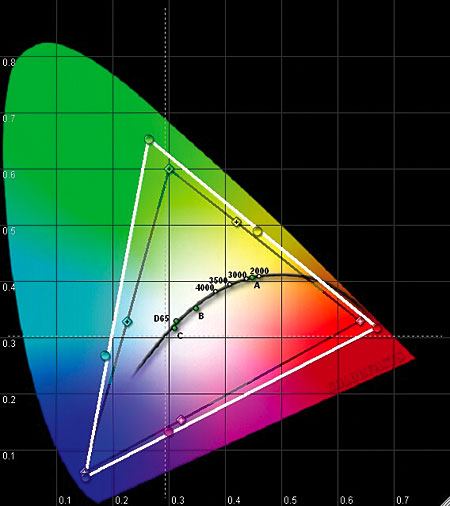Sharp Aquos LC-52XS1U-S Limited Edition LCD HDTV HT Labs Measures
Black: 0.001
White: 28.4
Full-On/Full-Off Contrast Ratio: 28,400:1
All of the measurements here were taken in the User AV Mode, adjusted for the most accurate picture. The Power Saving control was set to Off.
The full-on/full-off contrast ratio above (sometimes referred to as the peak contrast ratio, the sequential contrast ratio, or the dynamic range) is impressive. We’re not surprised that it’s not even in the ballpark of the claimed 1,000,000:1 (which we would not be able to measure in any event!). Note that this reading was taken with the backlight set to –5, for comfortable viewing in a dark or dimly lit room. A higher backlight setting (the maximum is +16) would increase the white window reading and produce a higher peak contrast number, but with an uncomfortably bright image.
The color-tracking charts show how well a display adheres to the D65 standard white point. The tighter the overlap of the three primary colors, the nearer the result is to D65. The pre-calibration result is for the Low Color Temp setting. Post calibration, the result is only marginally improved. I discuss this issue in more detail in the main text of the review.

It isn’t uncommon for manufacturers to pump up the color gamut their sets produce. It can look impressive and stand out in the showroom. While it’s rarely unpleasant to look at even at home, it is not accurate for any current consumer source. The Sharp is no exception; it does not produce an accurate color gamut. The white triangle in the pie-shaped CIE chart shows the set’s color gamut in the Standard Color Gamut setting I used in the review. As discussed in the review, the CMS could not correct for these overly saturated colors. The Expanded color gamut, not shown here, was even more excessive.

The Sharp’s luma (black and white) resolution was exceptional up to the limit of our resolution test patterns in 1080i (measured in both HDMI and component) and 1080p (measured in HDMI). Its HD chroma (color) resolution was nearly as good. In both HDMI and component, 720p was excellent across the board. 480i/p was good to excellent except for 480i component, which was only satisfactory, with a clear rolloff visible at its 6.75-megahertz limit.
Overscan was zero in 1080i/p (in Dot by Dot—not available in other resolutions) and 720p (Full Screen). At 480i and 480p, it averaged about 2.5 percent per side (a 10-percent loss of overall picture area)—an acceptable figure. Dot-by-Dot produced perfect 1:1 pixel mapping.—TJN




